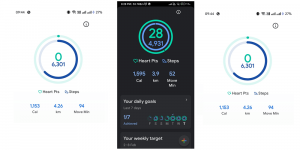
The fitness industry is harnessing the power of data analytics to gain valuable insights and make informed decisions, and to drive growth, improve operations, and enhance the member experience.
For years, Vitality Fitness had been the go-to place for fitness enthusiasts, offering state-of-the-art equipment, a wide range of classes, and a supportive community. The gym thrived, with a loyal customer base and a steady stream of new members joining every month. Life was good, and the future looked bright for Vitality Fitness.
However, the global pandemic changed it all.
Although things are back to normal now, Vitality Fitness is now struggling to attract new customers and retain existing ones.
The management then decided to use data analytics to identify target segments, to understand the areas where the gym could add value, and for guidance on the use of appropriate customer acquisition and retention approaches.
Slowly but surely, the tide has began to turn for the gym.
The story is a testament to the power of data analytics in the fitness industry, and there are many such success stories.
As the fitness industry moves forward, data analytics will continue to play a crucial role in shaping the success of businesses like Vitality Fitness.
Benefits of Data Analytics in the Fitness Industry
Data analytics for fitness businesses involves the collection, analysis, and interpretation of data related to various aspects of their operations, including member behavior, facility usage, marketing effectiveness, and financial performance.
Fitness businesses can unlock a multitude of benefits by harnessing the power of data analytics.
Improved Decision-Making
By analyzing data on member behavior, preferences, and market trends, fitness businesses can gain valuable insights into what works and what doesn’t, which can be helpful to customize marketing campaigns, service offerings, and operational improvements.
Enhanced Member Experience
By collecting and analyzing individual member data, such as goals, preferences, and progress, a fitness business can deliver tailored services and recommendations.
For example, data analytics can help make personalized workout plans, provide targeted nutrition advice, and by using tracking tools, a fitness business can help members stay motivated and engaged. This level of personalization enhances member satisfaction and cultivates a sense of loyalty, leading to higher retention rates and positive word-of-mouth referrals.
Optimized Resource Allocation
Data analytics can provide insights into facility usage patterns, equipment utilization, and class attendance. By analyzing this data, businesses can optimize resource allocation, ensuring that the right services, equipment, and staff are available at the right time. A fitness business can use this knowledge to make informed decisions about investments in new equipment or expansion.
Targeted Marketing Efforts
By analyzing data on member demographics (such as age, gender), preferences, and past behavior, businesses can create targeted marketing campaigns that resonate with their audience, which can result in higher conversion rates, increased member acquisition, and improved return on marketing investments.
Operational Efficiency
By analyzing operational data, such as staff scheduling, facility maintenance, and inventory management, businesses can identify areas for improvement. For instance, data analytics can help optimize class schedules based on member demand, reduce equipment downtime through proactive maintenance, and ensure adequate stock levels of essential supplies.
Data-Driven Innovations
By leveraging insights derived from data, businesses can identify emerging trends, anticipate member needs, and develop new services or programs that cater to those demands.
By staying ahead of these trends, fitness businesses can differentiate themselves in the market and offer unique experiences that attract and retain members.
Implementing Data Analytics in a Fitness Business
Here how you can incorporate data analytics in your fitness business.
Define your business objectives and determine the metrics that you want to capture. Based on that, you can decide to collect data such as member information, usage patterns, sales data, marketing metrics, and financial records.
Ensure data is collected accurately and consistently. Implement processes to validate and clean the data regularly, reducing errors and maintaining data integrity.
Use appropriate technology solutions such as customer relationship management (CRM) systems, point-of-sale (POS) systems, and access control systems to automate data collection. This streamlines the process and ensures data accuracy.
You will need to train the staff to effectively use the analytics tool.
Implement appropriate access controls and encryption methods to protect data from unauthorized access.
Case Studies and Success Stories
Here are a few case studies, success stories and real-world examples of fitness businesses that have successfully implemented data analytics and achieved tangible benefits and positive outcomes.
Case Study: FitLife Gym
By analyzing member usage patterns, class attendance, and demographic data, fitness chain FitLife Gym identified a significant drop in attendance among members who had joined within the past three months.
Using this insight, FitLife Gym implemented targeted onboarding programs, including personalized workout plans and goal tracking features. They also sent automated email reminders to members to encourage class attendance. As a result, they observed a 20% increase in member retention within the first six months of implementing these data-driven initiatives.
Success Story: FitTech Wearables
FitTech Wearables, a startup specializing in fitness tracking devices, utilized data analytics to improve their product offerings. By collecting and analyzing data from their wearable devices, including step counts, heart rate, and sleep patterns, FitTech Wearables gained valuable insights into user behavior and preferences.
These insights allowed them to refine their product design, add new features based on user demands, and improve the accuracy of their activity tracking algorithms. Consequently, FitTech Wearables experienced a significant increase in customer satisfaction and loyalty, resulting in a 30% growth in sales within a year.
Case Study: FlexFit Studios
By analyzing member attendance patterns and demand for different class types, boutique fitness studio FlexFit Studios was able to identify underutilized time slots and classes with consistently high demand. Based on these insights, they restructured their class schedules, reallocating instructors and resources to match peak demand times. As a result, class attendance increased by 25%, leading to improved member satisfaction and increased revenue for the studio.
Future Trends in Data Analytics for Fitness Businesses
Here are some future trends to watch out for in data analytics for fitness businesses:
Advanced Wearable Technology
Wearable devices will become more sophisticated, collecting a broader range of data points such as biometric data, sleep patterns, stress levels, and more. This data will provide fitness businesses with deeper insights into member behavior, enabling more precise personalization and customization of fitness programs.
Artificial Intelligence, Machine Learning, Predictive Analysis
Artificial intelligence (AI) and machine learning (ML) will further enhance data analytics capabilities in the fitness industry. These algorithms will enable businesses to analyze vast amounts of data and uncover complex patterns and correlations, and will continuously learn and adapt based on member data, enabling more accurate predictions and personalized recommendations.
Integration of Multiple Data Sources
Fitness businesses will increasingly integrate data from multiple sources (wearable devices, mobile apps, CRM systems, social media platforms, and more) to gain a holistic view of their operations and member base.
Real-Time Analytics and Reporting
Real-time data analytics and reporting will become more prevalent, enabling fitness businesses to make immediate adjustments to class schedules, resource allocation, and marketing campaigns.
Closing Thoughts
Data analytics has become an indispensable tool for fitness businesses, providing valuable insights that drive strategic decision-making and enhance member experiences. As technology advances, future trends in data analytics for fitness businesses will continue to shape the industry. Advanced wearable technology, artificial intelligence, predictive analytics, integration of multiple data sources, real-time reporting, enhanced data visualization, and ethical considerations will play significant roles in driving data-driven strategies. As the industry continues to evolve, the strategic adoption of data analytics will be crucial for long-term success in the fitness business landscape.









Leave a Reply